Welcome to our comprehensive guide on caring for Cryptocoryne Spiralis, a stunning aquatic plant that has captured the hearts of aquarium enthusiasts.
Whether you’re a beginner or an experienced aquascaper, this article will provide you with expert insights and essential tips to help you successfully nurture and maintain Cryptocoryne Spiralis in your aquarium.
Cryptocoryne Spiralis, also known as Crypt Spiralis, boasts elegant, spiraling leaves that add a touch of natural beauty to any aquatic setup. Its hardy nature and ease of care make it an ideal choice for both newcomers and seasoned aquarists, as it can thrive in various tank conditions.
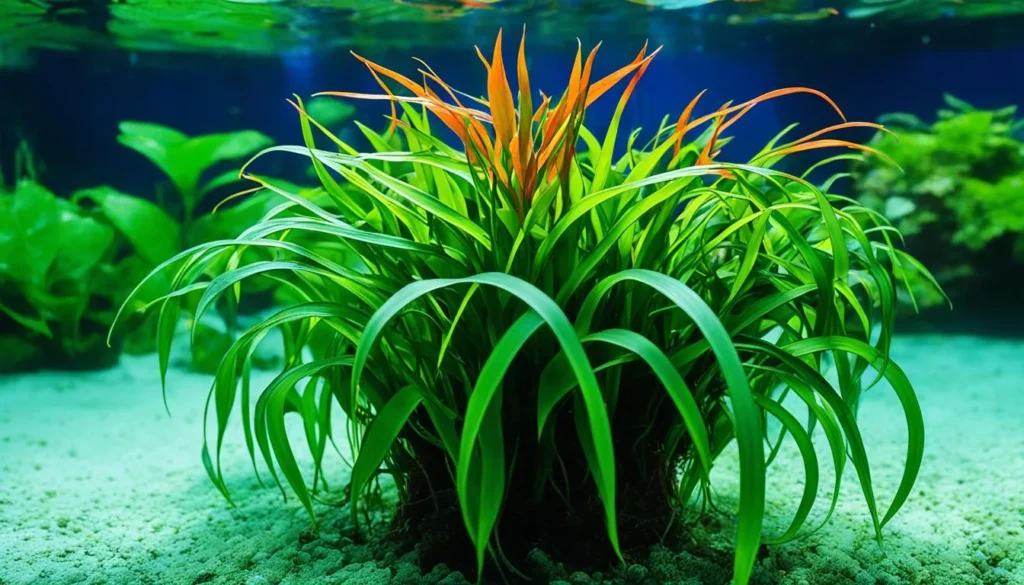
Key Takeaway
- Proper care and maintenance are essential for the health and vitality of Cryptocoryne Spiralis.
- Creating optimal growth conditions, including temperature, lighting, and nutrients, is crucial for the plant’s well-being.
- Understanding the unique appearance and growth stages of Crypt Spiralis is essential for its identification.
- Choosing the right tank size, substrate, and lighting are key factors in providing a suitable environment for Cryptocoryne Spiralis.
- Regular trimming, propagation, and careful selection of tank mates and companion plants contribute to a thriving aquarium ecosystem.
Quick Stats
| Attribute | Details |
| Scientific Name | Cryptocoryne spiralis |
| Common Name | Cryptocoryne Spiralis |
| Origin | Southeast Asia, specifically Sri Lanka and India |
| Height | 20-50 cm (8-20 inches) |
| pH Range | 6.0 – 7.5 |
| CO2 Requirement | Low to Moderate |
| Growth Rate | Slow to Moderate |
| Care Level | Easy to Moderate |
| Color Form | Green, with potential for reddish hues under high light |
| Water Conditions | 22-28°C (72-82°F), soft to moderately hard water |
| Max Size | Typically remains within the stated height range |
| Lighting | Low to Moderate, can tolerate low light conditions |
| Supplements | Minimal; may benefit from occasional root fertilization |
| Placement | Mid-ground to Background |
| Propagation | Through rhizome division or by planting offshoots |
What Is Cryptocoryne Spiralis?
Cryptocoryne Spiralis, also known as Crypt Spiralis, is a popular aquatic plant species that has gained significant traction in the world of aquascaping. This stunning plant features long, spiraling leaves that add a unique touch to any aquarium.
Cryptocoryne Spiralis is highly sought after due to its ease of care and its ability to thrive in various aquatic environments.
Natural Habitat And Origin
Cryptocoryne spiralis, commonly known as the spiral crypt or twisted vallisneria, originates from the tropical regions of Southeast Asia. It is native to countries such as India, Sri Lanka, Bangladesh, and Myanmar.
In its natural habitat, Cryptocoryne spiralis is typically found in marshes, swamps, and slow-moving streams with sandy or muddy substrates. It often grows submerged in shallow waters, where it forms dense colonies along the banks or edges of water bodies.
The plant is adapted to varying water conditions and can tolerate both shaded and partially shaded areas, depending on the depth of the water and the density of surrounding vegetation.
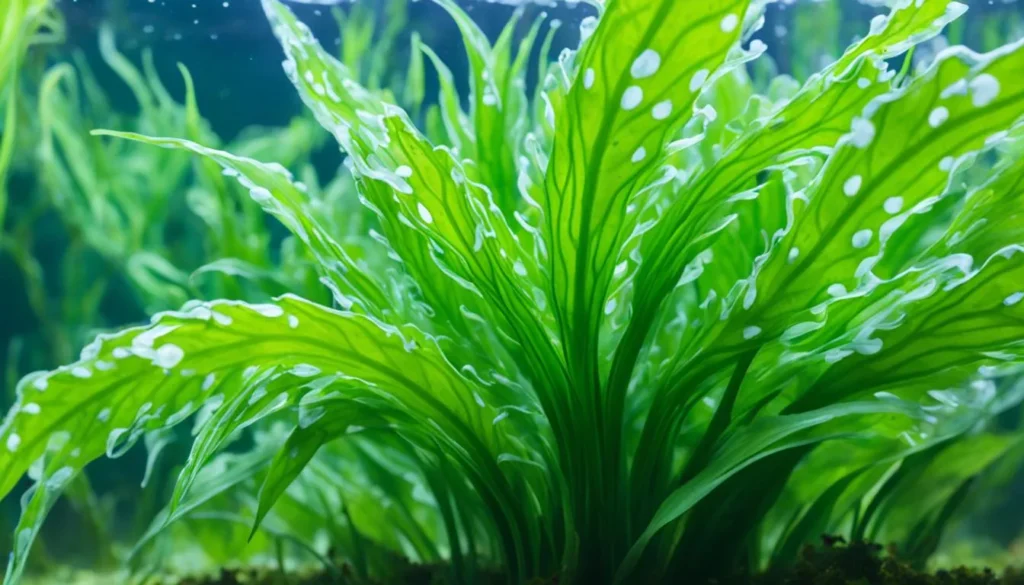
Physical Characteristics Of Crypt Spiralis
- Leaves: The leaves of Cryptocoryne spiralis are long, narrow, and typically measure between 20 to 40 centimeters (8 to 16 inches) in length. They are usually green in color and may exhibit some variation in shade depending on environmental factors.
- Shape: One of the most distinctive features of Cryptocoryne spiralis is the spiral or twisted growth pattern of its leaves. As the plant matures, the leaves tend to curve and twist along their length, giving the plant a unique and eye-catching appearance.
- Texture: The leaves of Cryptocoryne spiralis have a smooth and glossy texture, adding to the plant’s visual appeal. This texture contrasts with the more rigid or textured leaves of some other Cryptocoryne species.
- Roots: Like other Cryptocoryne species, Cryptocoryne spiralis develops a robust root system composed of thin, fibrous roots. These roots anchor the plant in the substrate and absorb nutrients and water from the surrounding environment.
Understanding Lighting Intensity And Spectrums
- When it comes to lighting intensity, Cryptocoryne Spiralis prefers moderate to low light levels. In the wild, this plant thrives in the shade of overhanging trees and dense vegetation. Therefore, replicating similar lighting conditions in your aquarium will help maintain its natural growth patterns.
- The spectrums of light that Crypt Spiralis responds well to are typically in the range of 5000K to 7000K, which fall under the spectrum of cool white to sunlight. Providing a balanced combination of these spectrums will help promote healthy growth and vibrant coloration in this aquatic plant.
- It’s important to note that excessive lighting intensity or exposure to spectrums outside of the recommended range can result in unwanted algae growth and stress on Cryptocoryne Spiralis. Maintaining optimal lighting conditions is crucial for the plant’s overall health and well-being.
RELATED: The Aquatic Wonder Bacopa Australis To Transform Your Aquascape
Temperature And Water Chemistry For Healthy Growth
- Providing the correct temperature and maintaining appropriate water chemistry is vital for the healthy growth of Cryptocoryne Spiralis. As these plants originate from tropical regions, they thrive in warm water conditions.
- The ideal temperature range for Cryptocoryne Spiralis is between 75°F and 82°F (24°C – 28°C). Keeping the water within this range promotes optimal growth and vitality. Additionally, aim for a slightly acidic to neutral pH level, ideally between 6.0 and 7.5, and maintain a moderate hardness level between 2 and 12 dKH.
- It is crucial to note that sudden or extreme fluctuations in temperature or water chemistry can stress the plants and hinder their growth. Therefore, maintaining stable and consistent conditions is essential to ensure the healthy development of Cryptocoryne Spiralis. Regular water testing and monitoring will help you make any necessary adjustments to maintain the desired parameters.
Enhancing Water Quality With Crypt Spiralis
- Cryptocoryne Spiralis plays a vital role in enhancing water quality in your aquarium. Its dense foliage absorbs and assimilates excess nutrients, such as nitrates, phosphates, and ammonia, which can lead to algae growth and poor water conditions. By absorbing these compounds, Crypt Spiralis helps maintain balanced nutrient levels, promoting a healthier environment for aquatic life.
- Additionally, Crypt Spiralis releases oxygen during photosynthesis, improving the oxygenation of the water. This is especially beneficial for fish and other oxygen-dependent organisms, promoting their overall well-being and reducing stress.

Mixing Gravel, Sand, And Nutrients For Proper Substrate
- When selecting a substrate for Cryptocoryne Spiralis, a mix of gravel, sand, and nutrients is highly recommended. This combination provides a stable base for the plant to anchor its roots and absorb essential nutrients for healthy growth.
- Mixing gravel and sand creates a varied texture that allows for better water circulation and prevents compaction. This promotes root development and prevents the substrate from becoming too dense, ensuring adequate oxygenation of the roots.
- Incorporating nutrient-rich additives into the substrate, such as clay or fertilizers specifically designed for aquatic plants, can provide a steady supply of essential nutrients that Cryptocoryne Spiralis requires. These nutrients support overall plant growth, leaf coloration, and root development.
- When mixing the substrate, it is essential to achieve the right balance. Aim for a ratio of approximately 70% gravel and 30% sand, while adding nutrients according to the manufacturer’s instructions.
Efficient Fertilization Methods For Cryptocoryne Spiralis
- Proper fertilization is essential for the healthy growth of Cryptocoryne Spiralis. To ensure the vitality and vibrancy of this aquatic plant in your tank, it is important to employ efficient fertilization methods that provide the necessary nutrients and supplements for optimal development.
- One effective fertilization method for Cryptocoryne Spiralis is the use of root tabs or substrate fertilizers. These specially formulated fertilizers contain essential macronutrients like nitrogen (N), phosphorus (P), and potassium (K), as well as micronutrients such as iron (Fe) and trace elements. By placing these fertilizers directly into the substrate near the plant’s roots, you can ensure that the nutrients are readily available for absorption.
Placement Option
- Background Planting: Due to its tall and slender leaves, Cryptocoryne spiralis is well-suited for placement in the background of the aquarium. Planting it at the rear corners or along the back wall of the tank can create a lush green backdrop that adds depth to the aquascape.
- Midground Accent: While Cryptocoryne spiralis is often used as a background plant, it can also be placed in the midground to add vertical interest and texture to the aquascape. Planting it slightly off-center or in clusters amidst other foreground or midground plants can create a visually dynamic layout.
- Island Planting: For larger aquariums or aquascapes with open spaces, consider planting Cryptocoryne spiralis in small groups or islands throughout the tank. This placement option allows the plant to stand out as focal points while still contributing to the overall balance and harmony of the aquascape.
- Foreground Planting (Advanced Aquascapes): In some advanced aquascaping layouts, Cryptocoryne spiralis may be used in the foreground, especially in larger tanks where its height can be controlled through regular trimming. This placement option requires careful consideration of the plant’s growth habits to prevent shading and overcrowding of other foreground plants.
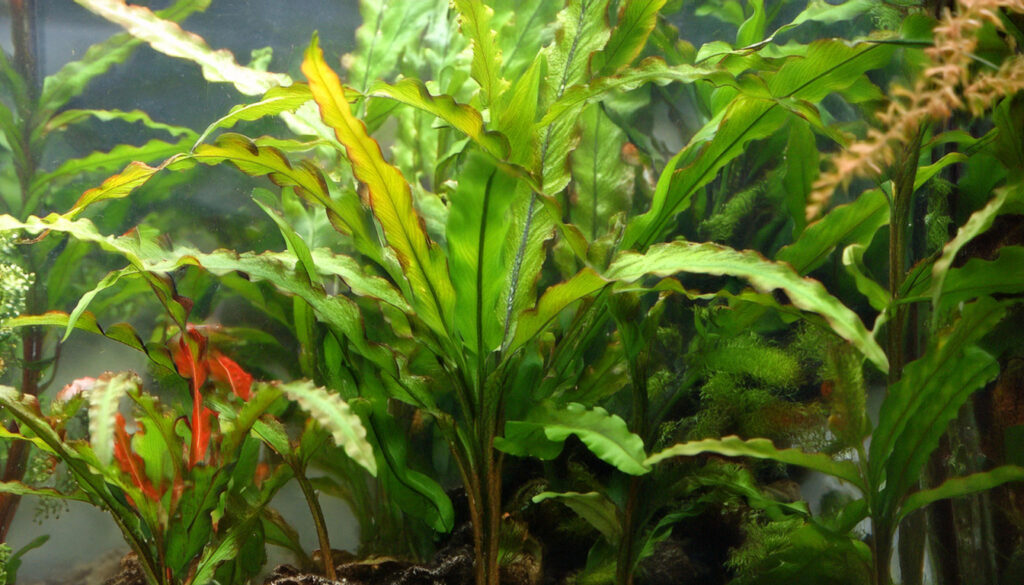
Choosing The Right Aquarium Size
- When setting up a tank for Cryptocoryne Spiralis, it is essential to choose the right aquarium size to accommodate its growth habits. These plants, known for their long, spiral-shaped leaves, require sufficient space to spread out and thrive. Selecting an appropriately sized tank will not only provide ample room for the plants but also ensure a visually pleasing aquascape.
- For a single plant or a small group of Cryptocoryne Spiralis, a nano or small aquarium with a capacity of 10-20 gallons is suitable. However, if you plan to create a lush, densely planted tank with multiple specimens, opt for a larger aquarium with a capacity of 30 gallons or more. This will allow the plants to develop their full growth potential and create an impressive display.
- Choosing the right aquarium size will not only benefit the Cryptocoryne Spiralis but also provide a comfortable environment for other tank inhabitants, promoting overall ecosystem stability.
| Aquarium Size | Temperature Range | pH Level | Hardness Level |
| 10-20 gallons (nano/small) | 75°F – 82°F (24°C – 28°C) | 6.0 – 7.5 | 2 – 12 dKH |
| 30 gallons or more | 75°F – 82°F (24°C – 28°C) | 6.0 – 7.5 | 2 – 12 dKH |
Choosing Tank Mates And Companion Plants For Cryptocoryne Spiralis
When creating an aquascape with Cryptocoryne Spiralis, selecting suitable tank mates and companion plants is crucial for establishing a harmonious and visually appealing environment.
To ensure the well-being of Cryptocoryne Spiralis and its tank mates, it is important to consider their compatibility in terms of water parameters, behavior, and size.
Tank mates should have similar temperature and water chemistry requirements to Crypt Spiralis to promote optimal conditions for all inhabitants. Additionally, selecting species with peaceful temperaments will minimize the risk of aggression or territorial disputes.
Some suitable tank mates for Cryptocoryne Spiralis include:
- Neon Tetras
- Otocinclus Catfish
- Cherry Shrimp
- Harlequin Rasboras
- Amano Shrimp
These species are known to be compatible with Crypt Spiralis and can create a visually appealing aquatic community. However, it is important to research each species and their specific care requirements before introducing them to your tank.
In addition to tank mates, companion plants play a vital role in creating a diverse and visually pleasing aquascape. When selecting companion plants for Crypt Spiralis, consider plants that have similar growth requirements, such as lighting and nutrient needs.
This will ensure that all plants can thrive together and create a balanced ecosystem.
Some complementary flora options for Cryptocoryne Spiralis include:
- Anubias
- Java Fern
- Dwarf Hairgrass
- Amazon Sword
- Water Wisteria
These plants not only provide visual contrast but can also serve as natural hiding spots or grazing areas for tank inhabitants. Incorporating a diverse range of plants adds depth and complexity to your aquascape, creating a more captivating and natural-looking habitat.
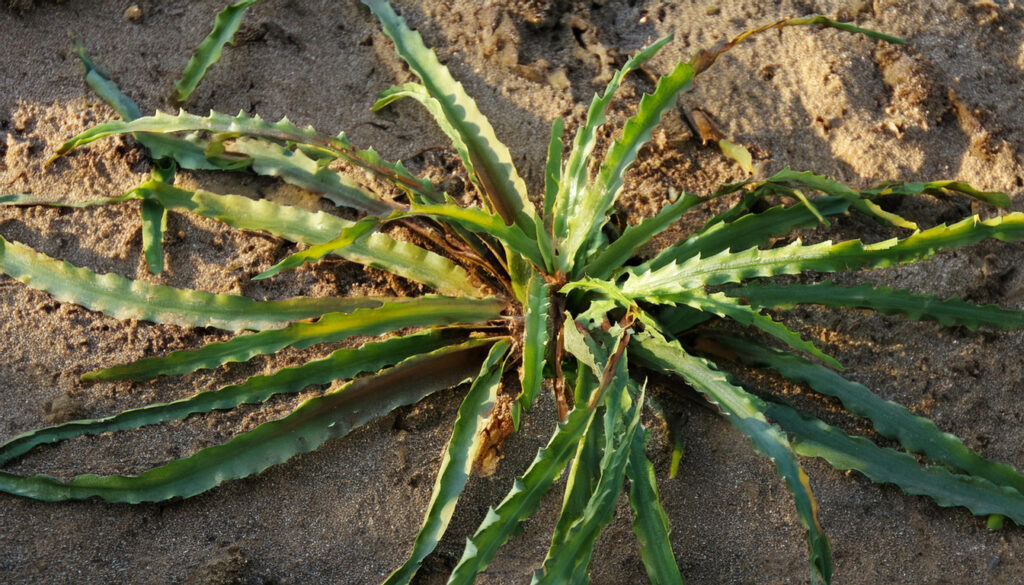
Plant Nutrition Needs
Cryptocoryne spiralis, like other aquatic plants, requires a balanced supply of both macro and micro nutrients to support healthy growth and development. Here’s an explanation of the macro and micro nutrients essential for the nutrition of Cryptocoryne spiralis:
Macro Nutrients
- Nitrogen (N): Nitrogen is a crucial component of chlorophyll, the pigment responsible for photosynthesis. It is necessary for overall plant growth and vitality. Nitrogen deficiency can manifest as stunted growth and yellowing of leaves.
- Phosphorus (P): Phosphorus is involved in energy transfer and the formation of nucleic acids, which are essential for plant metabolism and growth. It plays a vital role in root development and flowering. Phosphorus deficiency can lead to poor root growth and dark green or purplish leaves.
- Potassium (K): Potassium regulates water uptake, enzyme activation, and photosynthesis. It contributes to plant vigor, disease resistance, and overall stress tolerance. Potassium deficiency may result in weak stems, yellowing or necrosis of leaf margins, and decreased growth.
- Magnesium (Mg): Magnesium is a central component of chlorophyll molecules and is involved in photosynthesis and enzyme activation. It plays a crucial role in nutrient uptake and carbohydrate metabolism. Magnesium deficiency can cause chlorosis (yellowing) of older leaves.
Micro Nutrients
- Iron (Fe): Iron is essential for chlorophyll synthesis and electron transport in photosynthesis. It also plays a role in enzyme activation and nitrogen metabolism. Iron deficiency can lead to chlorosis, with new leaves appearing pale or yellow.
- Manganese (Mn), Zinc (Zn), Copper (Cu), and Molybdenum (Mo): These micronutrients are involved in various enzyme systems and metabolic processes within the plant. Deficiencies in these micronutrients can manifest as distorted leaf growth, leaf discoloration, or reduced plant vigor.
RELATED: Grow Cryptocoryne Lutea For Vibrant Aquariums With This Simple Guide
Cultivating Cryptocoryne Spiralis
Cultivating Cryptocoryne spiralis requires careful preparation, planting, and ongoing care to ensure healthy growth and development. Here’s a guide to cultivating Cryptocoryne spiralis in your aquarium:
Preparation
- Substrate Preparation: Cryptocoryne spiralis thrives in a nutrient-rich substrate. Before planting, ensure that the substrate is well-established and contains sufficient nutrients for plant growth. You can use specialized aquatic plant substrates or enrich the substrate with root tabs or nutrient-rich additives.
- Tank Setup: Set up the aquarium according to the needs of Cryptocoryne spiralis. Provide adequate lighting, filtration, and water circulation to create a conducive environment for plant growth. Maintain stable water parameters, including temperature, pH, and hardness, within the recommended range for Cryptocoryne species.
Planting
- Selecting Healthy Specimens: Choose healthy Cryptocoryne spiralis specimens from a reputable source. Look for plants with vibrant green leaves, strong roots, and no signs of disease or pests.
- Planting Technique: Carefully remove Cryptocoryne spiralis from its pot or packaging, taking care not to damage the roots or leaves. Plant each specimen in the substrate, ensuring that the crown (where the roots meet the stem) is positioned slightly above the substrate surface to prevent rotting. Space the plants accordingly, leaving room for growth and expansion.
- Root Anchoring: Gently press the substrate around the base of each plant to anchor the roots securely. Avoid burying the crown too deeply, as this can lead to rot or suffocation of the plant.
Care And Maintenance
- Watering: Maintain consistent water conditions by performing regular water changes and monitoring water parameters. Cryptocoryne spiralis prefers slightly acidic to neutral water with moderate hardness. Avoid sudden fluctuations in temperature or water chemistry, as this can stress the plants.
- Fertilization: Provide adequate nutrients for Cryptocoryne spiralis through a balanced fertilization regimen. Use liquid or granular fertilizers specifically formulated for aquarium plants, ensuring that both macro and micro nutrients are included. Consider supplementing with root tabs or substrate additives for targeted nutrient delivery to the plant roots.
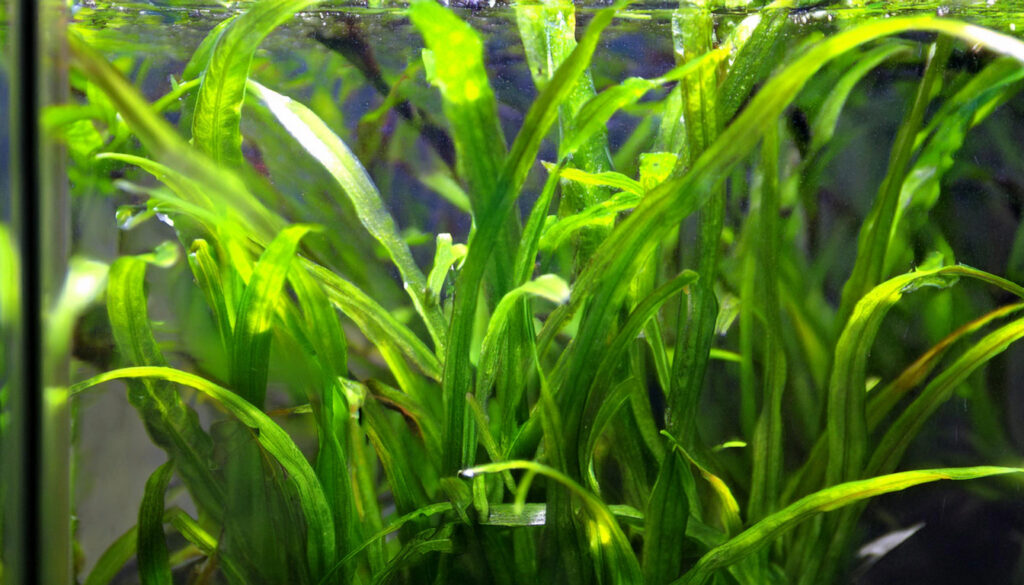
Propagation And Maintenance Of Cryptocoryne Spiralis
- Propagation and maintenance are essential aspects of caring for Cryptocoryne Spiralis. By implementing simple trimming techniques, you can keep the plant tidy and promote healthy growth. Additionally, there are methods for encouraging the formation of runners and new growth in Crypt Spiralis, allowing you to expand your plant population and maintain its overall health.
- Trimming Cryptocoryne Spiralis involves removing any dead or decaying leaves, which helps maintain the plant’s appearance and prevents the accumulation of debris in your aquarium.
- To trim the plant, carefully locate any damaged or discolored leaves and use sharp scissors or aquascaping tools to remove them at the base. Be sure to avoid cutting the healthy foliage or damaging the plant’s crown.
- Encouraging the formation of runners and new growth in Crypt Spiralis can help propagate the plant and create a lush and thriving aquarium. Runners are lateral shoots that emerge from the parent plant and produce new plants as they grow.
- To promote runner formation, provide adequate lighting, nutrient-rich substrate, and regular fertilization. As the runners grow, they will develop their root system, allowing them to establish new plants.
- Once the new plants have rooted, you can separate them from the parent plant and transplant them into different areas of your aquarium.
Benefits Of Planting Cryptocoryne Spiralis
- Natural Aesthetic: Cryptocoryne spiralis adds a natural and visually appealing element to your aquarium with its long, slender leaves that sway gently in the water. Its vibrant green coloration provides a refreshing contrast to other plants and aquarium decor, enhancing the overall aesthetics of the tank.
- Oxygenation: Like all aquatic plants, Cryptocoryne spiralis contributes to oxygenation by absorbing carbon dioxide and releasing oxygen through photosynthesis. This helps maintain healthy oxygen levels in the aquarium, benefiting fish, invertebrates, and other aquatic inhabitants.
- Water Filtration: Cryptocoryne spiralis helps improve water quality by absorbing excess nutrients, organic waste, and pollutants from the water column. As the plants grow, they uptake nutrients such as nitrates and phosphates, helping to prevent algae overgrowth and maintaining a balanced ecosystem.
- Habitat Enhancement: The dense foliage of Cryptocoryne spiralis provides shelter and hiding places for fish, shrimp, and other aquatic creatures, helping to reduce stress and promote natural behaviors. It also creates breeding areas for certain species, contributing to biodiversity in the aquarium.
Ideal Environments For Cryptocoryne Spiralis
Cryptocoryne Spiralis thrives in a range of aquatic environments, making it a versatile addition to any aquarium. When it comes to tank setup, there are a few key factors to consider in order to provide the ideal environment for the growth and well-being of Crypt Spiralis.
| Parameters | Ideal Range |
| Temperature | 72°F-82°F (22°C-28°C) |
| pH | 6.0-7.5 |
| Lighting | Moderate to high intensity |
| Substrate | Rich in nutrients, like aquatic soil or a nutrient-rich gravel/sand mix |
| Water Flow | Moderate |
| C02 | Optional, but supplemental CO2 can promote faster growth |
Creating A Natural Habitat For Aquarium Inhabitants
- Cryptocoryne Spiralis provides a natural habitat for various aquarium inhabitants. The plant’s dense foliage offers shelter, hiding spots, and spawning sites for small fish, invertebrates, and fry.
- The root system of Crypt Spiralis creates a complex maze of tunnels and crevices, providing a hiding place for shy or territorial species, like catfish and shrimp, and promoting a more natural and enriching environment for your aquatic pets.
- Furthermore, the plant’s foliage acts as a substrate for beneficial microorganisms that contribute to the overall biological balance of the aquarium. These microorganisms help break down waste and maintain a healthy nitrogen cycle, further improving water quality and supporting the well-being of other tank inhabitants.

Algae Prevention Through Balanced Lighting
- One of the challenges in maintaining a healthy aquarium with Cryptocoryne Spiralis is managing algae growth. Too much light or light spectrums that promote algae growth can lead to unsightly and potentially harmful algae blooms.
- One effective method to prevent algae growth is to maintain a balanced lighting setup. This involves ensuring the right intensity and spectrums for the plant while avoiding excessive lighting duration. A photoperiod of 8-10 hours a day is typically sufficient for Crypt Spiralis without encouraging excessive algae growth.
- Additionally, implementing a regular maintenance routine that includes algae removal and water parameter monitoring can further prevent algae from overtaking the tank. By providing the right lighting conditions and diligently managing algae, you can create a visually appealing and healthy environment for your Cryptocoryne Spiralis.
| Lighting Needs | Algae Prevention | |
| Lighting Intensity | Moderate to low light levels | Balanced lighting setup |
| Lighting Spectrums | 5000K to 7000K (cool white to sunlight) | Maintain appropriate photoperiod (8-10 hours) |
Steps To Properly Plant Crypt Spiralis In Substrate
Properly planting Cryptocoryne Spiralis is essential for ensuring its successful growth and establishment in your aquarium. Follow these step-by-step instructions to plant Crypt Spiralis in the substrate:
- Prepare the substrate: Before planting, ensure that the substrate is well-prepared. Clean any debris or excess dirt from the substrate and create a level surface for planting.
- Choose the right location: Select a suitable spot in your aquarium where the Crypt Spiralis will receive adequate lighting and have enough space to grow. Consider the plant’s potential height and spread when choosing the location.
- Dig a hole: Gently dig a small hole in the substrate using your fingers or a planting tool. Make sure the hole is deep enough to fully accommodate the plant’s root system.
- Place the plant: Carefully place the Cryptocoryne Spiralis in the hole, ensuring that the roots are fully submerged in the substrate and the crown is above the surface. The crown is the area where the leaves emerge from the root system.
- Cover the roots: Gently cover the roots with the substrate, ensuring they are securely held in place. Avoid burying the crown as it needs to be exposed to air and light for optimal growth.
- Press down gently: Lightly press down on the substrate around the plant to secure it in place and provide stability.
Conclusion
This comprehensive guide has provided valuable insights into the care, tank requirements, and propagation of Cryptocoryne Spiralis. By following the tips and guidelines outlined in this article, you can create a thriving aquarium environment with this stunning plant.
We hope that this guide has equipped you with the knowledge and confidence to successfully care for Cryptocoryne Spiralis and enjoy its beauty in your aquatic setup.
RELATED: How To Plant Ceratopteris Siliquosa In Your Aquarium?
Frequently Asked Questions
What Makes Cryptocoryne Spiralis Different From Other Cryptocoryne Species?
Cryptocoryne Spiralis stands out due to its long, spirally twisted leaves, a distinctive feature not commonly seen in other species within the genus. This characteristic, along with its robust nature and adaptability to various water conditions, makes it a favored choice for aquarium enthusiasts looking to add a unique texture and greenery to their aquatic setups.
How Do I Propagate Cryptocoryne Spiralis In My Aquarium?
Propagation of Cryptocoryne Spiralis is relatively straightforward. The plant can be propagated through runners that form naturally. Once a runner has developed a few leaves and roots, it can be carefully separated from the mother plant and replanted in another part of the aquarium substrate. Ensure the new planting site has adequate lighting and nutrients to encourage growth.
Can Cryptocoryne Spiralis Grow In Low-Light Conditions?
Yes, Cryptocoryne Spiralis can thrive in low-light conditions, making it an excellent choice for aquariums with limited lighting. However, brighter lighting will encourage more vigorous growth and enhance the plant’s leaf coloration. It’s important to find a balance to prevent algae growth while promoting healthy plant development.
What Type Of Substrate Is Best For Cryptocoryne Spiralis?
Cryptocoryne Spiralis prefers a nutrient-rich substrate to support its root system and promote healthy growth. A substrate that is fine enough to allow easy root penetration yet dense enough to hold the plant in place is ideal. Incorporating clay or laterite into the substrate can provide additional nutrients beneficial for this plant’s growth.
How Does Cryptocoryne Spiralis Respond To Changes In Water Conditions?
Cryptocoryne Spiralis is known for its adaptability to a wide range of water conditions but can be sensitive to sudden changes, which may cause “Crypt melt” — where the plant’s leaves disintegrate.
To avoid this, any changes to water parameters (such as pH, hardness, and temperature) should be made gradually, allowing the plant to acclimate without stress. Regular monitoring and stable maintenance of water conditions will help ensure the health and longevity of Cryptocoryne Spiralis in your aquarium.
- Unveiling The Wonders Of Riccia Fluitans In Aquascapes - August 7, 2024
- Vallisneria Gigantea Var. Guide To Care And Cultivation At Home - July 31, 2024
- Vesicularia Dubyana Care & Growth Guide Tips For Beginner Gardeners - July 30, 2024
